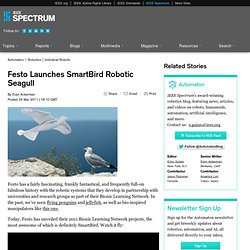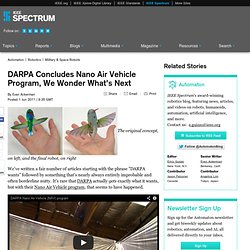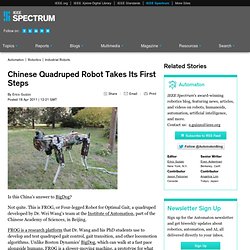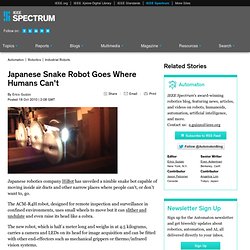Animal Robots
> Robotics
Watch Festo's SmartBird Robot Soar Over TED Conference. Festo Launches SmartBird Robotic Seagull. Festo has a fairly fascinating, frankly fantastical, and frequently full-on fabulous history with the robotic systems that they develop in partnership with universities and research groups as part of their Bionic Learning Network.

In the past, we've seen flying penguins and jellyfish, as well as bio-inspired manipulators like this one. Today, Festo has unveiled their 2011 Bionic Learning Network projects, the most awesome of which is definitely SmartBird. Watch it fly:
A robot that flies like a bird. DARPA Concludes Nano Air Vehicle Program, We Wonder What's Next. The original concept, on left, and the final robot, on right We've written a fair number of articles starting with the phrase "DARPA wants" followed by something that's nearly always entirely improbable and often borderline nutty.

It's rare that DARPA actually gets exactly what it wants, but with their Nano Air Vehicle program, that seems to have happened. As the above video shows, it was definitely not an easy process to make a life sized, fully controllable surveillance robot that's more or less indistinguishable for a hummingbird, but AeroVironment managed to pull it off. Of the technical goals and milestones that DARPA set out for the robot, it managed to meet all and exceed many: Demonstrate precision hover flight within a virtual two-meter diameter sphere for one minute. AeroVironment says that it would take a decade to make this robot ready for deployment, but DARPA doesn't just hand out piles of cash to make cool stuff for no reason.
DARPA Nano Air Vehicle (NAV) program
Chinese Quadruped Robot Takes Its First Steps. Is this China's answer to BigDog?

Not quite. This is FROG, or Four-legged Robot for Optimal Gait, a quadruped developed by Dr. Wei Wang's team at the Institute of Automation, part of the Chinese Academy of Sciences, in Beijing. FROG is a research platform that Dr. Wang and his PhD students use to develop and test quadruped gait control, gait transition, and other locomotion algorithms. "I hope it can find entertainment applications in dinosaur museums or expos," he tells me. FROG-I, the group's first version, is about 1 meter tall, weighs in at 55 kilograms, and uses DC motors. An on-board computer running real-time Linux performs sensing and actuator control, and communicates with a host computer through a wireless connection. Dr. I ask Dr. "BigDog is marvelous," he says. But he adds that this is "only preliminary research" and his group plans to improve FROG if they have enough resources in the future.
Images and video: Institute of Automation/Chinese Academy of Sciences. Chinese Quadruped Robot Takes Its First Steps. Remote Control Cyborg Roaches to Invade Classrooms. Getting kids involved in, and invested in, robotics and cybernetics isn't an easy task.

That very first step, helping them to realize that hey wow they can actually do it, is a tough one. Backyard Brains has come up with what looks to be a fun (and more importantly cheap) way of bringing robotics, cybernetics, and neurobiology into the classroom, as long as you're not creeped out by bugs. The Backyard Brains Cockroach Cerebral Enslavement Kit (I made that name up) takes the guts out of a Hexbug (cost: $10), adds a little chip that can generate biophasic pulses, and wires it up to the antennas of a large cockroach.
By mimicking the signals that the roach's brain receives when one of its antennas runs into something, the insect can be steered left and right: For those of you concerned about the well-being of the cockroaches (I know I was!) The cockroaches only have the backpacks on for a couple minutes. Phew, I feel better now. [ Backyard Brains ] via [ AOL ]
First BiDirectional RoboRoach Prototype. Gecko Tail and RightingBot. Snake Robot Goes Where Humans Can't. Japanese robotics company HiBot has unveiled a nimble snake bot capable of moving inside air ducts and other narrow places where people can't, or don't want to, go.

The ACM-R4H robot, designed for remote inspection and surveillance in confined environments, uses small wheels to move but it can slither and undulate and even raise its head like a cobra. The new robot, which is half a meter long and weighs in at 4.5 kilograms, carries a camera and LEDs on its head for image acquisition and can be fitted with other end-effectors such as mechanical grippers or thermo/infrared vision systems. Despite its seemingly complex motion capabilities, "the control of the robot is quite simple and doesn't require too much training," says robotics engineer and HiBot cofounder Michele Guarnieri. "All [degrees of freedom] can be easily controlled by a game-style joystick, including the motion of recovering from an upside-down position.
" Watch the ACM-R4H in action:
Serpentina - ROSE2010 - Télécom ParisTech. Gliding snake. 01zpassaroprontoo.jpg (620×350)
NANO Hummingbird Drone. In a wing's wake. Robot fly. Robot goat feeds on gambler misfortune.





